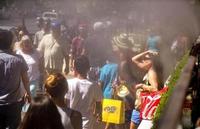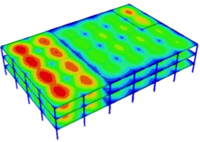-
Heat waves to become more frequent, severe

Climate change is set to trigger more frequent and severe heat waves in the next thirty years regardless of the amount of carbon dioxide (CO2) we emit into the atmosphere, a new study has shown. In the first half of the twenty-first century, these projections will occur regardless of the amount of CO2 emitted into the atmosphere. After then, the rise in frequency of extreme heat waves becomes dependent on the emission scenario adopted.
-
-
Monitoring slow earthquakes to predict larger events
Normal stick slip earthquakes typically move at a rate of three to 33 feet per second, but slow earthquakes, while they still stick and slip for movement, move at rates of about 0.004 inches per second, taking months or more to rupture. Slow earthquakes, however, often occur near traditional earthquake zones and may precipitate potentially devastating earthquakes. Monitoring slow earthquakes may thus provide a basis for reliable prediction in areas where slow quakes trigger normal earthquakes.
-
-
Climate change was proximate, not primary, cause of 2012 Great Plains drought: study

From May to July 2012, the Great Plains region of the western United States faced a powerful and unpredicted drought. Following seven months of normal rainfall, the drought was one of the largest deviations from seasonal precipitation rates seen in the region since observations began in 1895. Researches find that the drought fell within the bounds of natural atmospheric variability. The strength of the drought, they suggest, was a consequence of the multiple complex nonlinear systems that make up the climate system and did not critically depend on the existence of a strong external forcing.
-
-
Site of proposed Los Angeles skyscrapers may contain active seismic fault
Officials at New York-based Millennium Partners have agreed to dig a trench on a site proposed for two towers, thirty-nine and thirty-five stories tall, flanking the iconic Capitol Records building in Los Angeles. Opponents of the project say there is an active seismic fault under the planned location for the two towers, and the developer says the trench will allow geologists to see whether or not it would be safe to build the towers on the proposed site. Critics say that a panel of neutral experts, led by state officials, should do the geological investigation.
-
-
Better approach toward projecting, planning for rising sea levels on a warmer Earth
More useful projections of sea level are possible despite substantial uncertainty about the future behavior of massive ice sheets, according to Princeton University researchers. The researchers present a probabilistic assessment of the Antarctic contribution to twenty-first century sea-level change. Their methodology folds observed changes and models of different complexity into unified projections that can be updated with new information. This approach provides a consistent means to integrate the potential contribution of both continental ice sheets — Greenland and Antarctica — into sea-level rise projections.
-
-
Bolstering national grid resilience as extreme weather events intensify
Between 2003 and 2012, an estimated 679 widespread power outages in the United States occurred due to severe weather. A recent Congressional Research Service study estimates the inflation-adjusted cost of weather-related outages at $25 to $70 billion annually. A new White House report says that grid resilience is increasingly important as climate change increases the frequency and intensity of severe weather.
-
-
Guaranteeing communication coverage in the event of disaster
An EU-funded project that aims to develop a rapidly deployable wireless communication network for use in the aftermath of an emergency, disaster, or unexpected event, was commended recently at an international event.
-
-
A 34-story wooden skyscraper to be built in Stockholm
A Swedish architectural form is building a 34-story wood skyscraper in downtown Stockholm. Solid wood will be the predominant material in the building’s pillars and beams, while inside the apartments, walls, ceilings, fittings and window frames will be also constructed of wood.The firm says that wood is not only cheaper than either steel or concrete, but is also more fire resistant than both. This is due to 15 percent of wood mass being water, which will evaporate before the wood actually burns. In addition, logs get charred which protects the core.
-
-
Assessing the risks of global aftershock
The entire world becomes an aftershock zone after a massive magnitude (M) 7 or larger earthquake — but what hazard does this pose around the planet? Researchers are working to extend their earthquake risk estimates over a global scale, as they become better at forecasting the impact of aftershocks at a local and regional level.
-
-
Making storm warnings more exact, useful
The College of Staten Island (CSI)is the home of one of the most powerful mainframe computer systems in the country, an outgrowth of the City University of New York’s (CUNY) Decade of Science initiative. Following August 2011 Hurricane Irene, CSI scientistsset out to use that computing horsepower to generate scientific data hard enough to make the warnings something more than abstract. They fed millions of data points into the supercomputers, turning an admixture of geology, oceanography, climatology, and land surveys into a set of highly specific projections. Then, on 25 October 2012, Superstorm Sandy hit, and the actual water surges could be measured against the surge projections of the CSI model. On street after street, the computer model predicted flooding to within a foot of the actual surges.
-
-
Firefighting robot creates 3D images of burning buildings’ interiors for rescuers
Researchers develop novel robotic scouts that can help firefighters to assist in residential and commercial blazes. The robots will map and photograph the interior of burning buildings by using stereo vision. Working together both collaboratively and autonomously, a number of such vehicles would quickly develop an accurate augmented virtual reality picture of the building interior. They would then provide it in near real time to rescuers, who could better assess the structure and plan their firefighting and rescue activities.
-
-
Man-induced quakes to help in building safer, sturdier buildings

A team led by Johns Hopkins structural engineers is shaking up a building in the name of science and safety. Using massive moving platforms and an array of sensors and cameras, the researchers are trying to find out how well a two-story building made of cold-formed steel can stand up to a lab-generated Southern California quake.
-
-
Ten-fold increase in frequency of Katrina-magnitude storms this century
Tropical cyclones arise over warm ocean surfaces with strong evaporation and warming of the air. Since 1923, there has been a Katrina magnitude storm surge every twenty years. Researchers found that 0.4 degrees Celcius warming of the climate corresponds to a doubling of the frequency of extreme storm surges like the one following Hurricane Katrina. If the temperature rises an additional degree, the frequency will increase by 3-4 times, and if the global climate becomes two degrees warmer, there will be about ten times as many extreme storm surges.
-
-
Climate change threatens world food security
The last few decades have witnessed a substantial decline in the number of hungry people worldwide. Since 2007, however, progress has slowed and world food supply and demand have been precariously balanced — climate change threatens to tip this balance, most dramatically in the poorer areas of the world.
-
-
Climate change may fuel extreme wildfires
Climate change may be fueling the larger and more destructive wildfires which are scorching vast areas of the American West, according to new research. August 2012 saw 3.6 million acres burn in the region, the most of any August since 2000. There were, however, only 6,948 fires in August 2012 — the second fewest in that 12-year timeframe — meaning the fires were much larger.
-
More headlines
The long view
Trump Aims to Shut Down State Climate Policies
President Donald Trump has launched an all-out legal attack on states’ authority to set climate change policy. Climate-focused state leaders say his administration has no legal basis to unravel their efforts.
